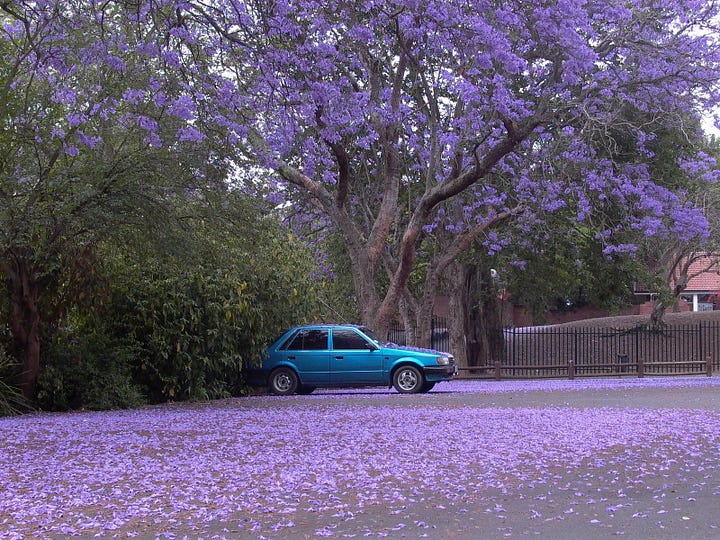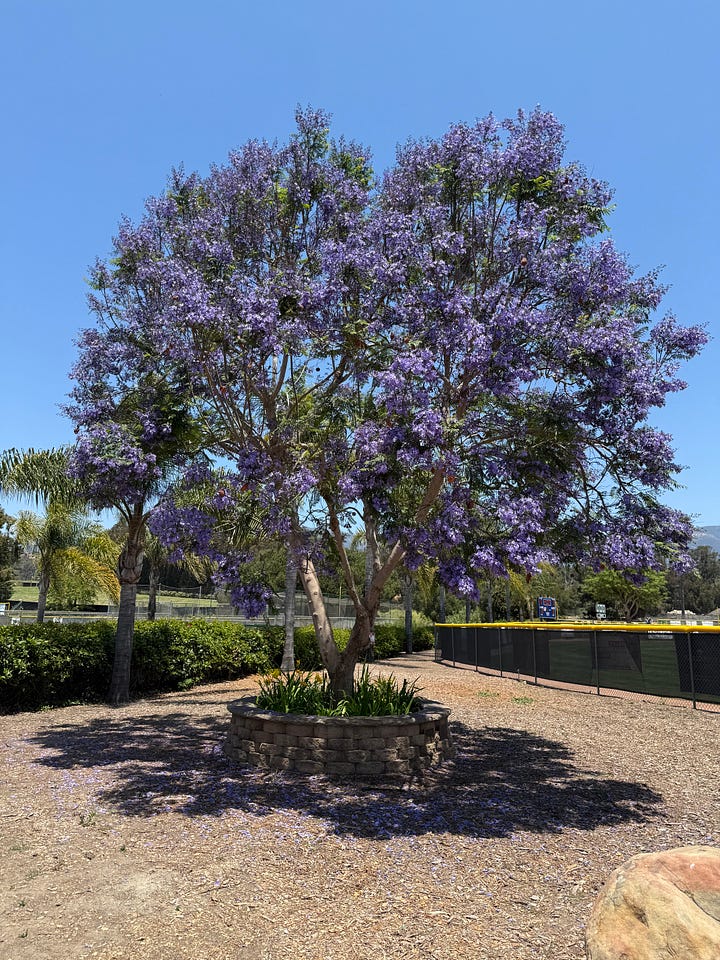It’s my pleasure to introduce you to Wade Graham, a writer, historian, and landscape designer with a practice based in Los Angeles who has contributed this post to Beachtown Bohemia. Wade’s a card-carrying Beachtown Bohemian: his substack The Extended Field often addresses concerns similar to mine (don’t miss his series Malibu vs. Nobu.) This post is a collaboration between us — in celebration of the theatre of the jacaranda tree at this time every year. I painted the jacaranda scene below per his art direction and in response to the piece.
Everyone knows that April showers bring May flowers, but little prepares for the sight of Jacarandas in bloom: rounded crowns of deep, saturated purple, a color seen in nature rarely, on nudibranchs and irises for example, popping suddenly up in the green tapestry of the urban forest, which, though is at its peak of green hue diversity now with new growth, seems drab in comparison. The surrealness of the bursts of color is amplified by the fact that, when the flowers appear, the tree is deciduous, leafless; only gradually, as the flowering recedes over a month or so, do the Jacaranda’s lacy, fernlike leaves replace them. They may appear randomly in the urban landscape, like puffs of deep-lavender smoke rising through the surface here and there, inexplicably. Or they are spectacularly arrayed as allées of street trees, looking like purple clouds from a distance, purple tunnels from within. Fallen blossoms carpet everything beneath: lawns, sidewalks, cars. It is a purple snow, a purple reign. Streets become temples dedicated to arboreal purple: Paloma Street in Pasadena, El Molino and Euclid Avenues in San Marino, North Whittier Drive in Beverly Hills, Stansbury Avenue in Sherman Oaks, Gothic Avenue in North Hills, and Index Street in Granada Hills. Some eager trees start to bloom in March, some last into summer, and some mount a more subdued, scattered Fall rebloom, but May and June are the peak of purple. Parts of Southern California, especially in the Los Angeles Basin, seem to explode with Jacarandas: parts of Santa Monica, Westwood, Beverly Hills, West Hollywood, and the San Gabriel Valley are peppered with them; Pasadena claims to have 1,654 trees, Los Angeles City, 20,000; there are said to be 58,000 trees in Los Angeles and Orange Counties. Hardy down to 30 degrees Fahrenheit, Jacarandas are planted In California everywhere on the frost-free coastal plain and in the warmer valleys. (They also grow in extreme south Texas and central and southern Florida, and of course Hawaii, where flowering trees form a year-round crazy quilt.) They have long been a small but gemlike part of local lore: Raymond Chandler wrote, “Beautiful hands are as rare as jacaranda trees in bloom, in a city where pretty faces are as common as runs in dollar stockings.” They’ve been called the cherry blossoms of Southern California, but here they don’t inspire the same hushed reverence as hanamimasu, cherry blossom viewing, does in Japan. Instead, a surprising number of people greet the purple abundance with grumpy complaints about sticky flowers blanketing their streets, sidewalks, lawns, and more angrily, their cars—ominously, they say, “damaging the paint job.” A popular newspaper columnist penned “Why I Hate Jacarandas” because their flowers “make a mess,” calling them “Satan’s bouquet” and more: “The tree stands for California at its worst: all flash, no substance, a pain left for others to clean up, inspiration for a thousand delusions and a million excuses.” To me this is churlish carping, an attempt to be funny by being contrary, an attempt to turn a phrase like Chandler, from a person who doesn’t value nature—which is messy in addition to being sublimely beautiful (think of sex, for example); someone who cares more about his car’s paint “job” than the seasonal rhythms of life that keep us alive on this lovely planet.
Jacaranda mimosifolia, native to Brazil, Argentina, and Bolivia; the genus named after an indigenous Tupi-Guarani word, garbled through Portuguese; the species meaning foliage like the mimosa acacias: “alternate, bipinnately compound, 8 to 15 inches long, 13 to 25 pairs of major leaflets, each with a similar number of minor leaflets, green above and paler below.” Jacaranda trees are valued all over the world, for their spectacular flowering, but also their hardiness: thriving in poor soils—even said to bloom more profusely in them—and tolerating air pollution, drought, dust, neglect. They are used as a landscape tree everywhere frost isn’t an issue: widely in China, India, Africa, Latin America, the Mediterranean (Spain, Portugal, Cyprus), the Middle East, Australia. They are one of the most common street trees in many cities, including Johannesburg, South Africa, where they vie for number one. In each place, no doubt, their surreal late Spring blooming takes people by surprise, every year; and they are no doubt loved/hated by the locals—who also likely think of the Jacaranda as their tree. Because how many of us know the far-flung origins, and the shared-ness, of the things that make up our worlds? The Jacaranda is an example of globalization to be sure, but also of localization. Globalization doesn’t always create planetary monocultures, like the Monsanto Roundup-Ready GM corn and soy seeds that increasingly blanket the earth and are replacing the Amazon rainforest. Sometimes what we call globalization creates multiple, subtle, local diversities, weaving together specific climates, natures, and cultures to make unique local flowerings, new traditions.
On my street, I’m grateful for the Jacarandas, which are now aflame in purple and blanketing the cars below them with sticky loveliness. I’m also grateful that I don’t usually have to park my car under them.




Beachtown Bohemia is paywall free. You can support me by liking this post (heart button at the top) and sharing it with anyone you feel would appreciate it.









Beautiful 💜💜💜